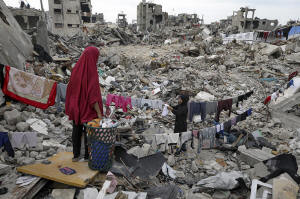Israel cut off food and supplies to Gaza. Aid groups are scrambling.
What's happening on the ground?
[March 05, 2025]
By JULIA FRANKEL and SAMY MAGDY
JERUSALEM (AP) — Israel’s cutoff of food, fuel, medicine and other
supplies to Gaza’s 2 million people has sent prices soaring and
humanitarian groups into overdrive trying to distribute dwindling stocks
to the most vulnerable.
The aid freeze has imperiled the tenuous progress aid workers say they
have made to stave off famine over the past six weeks during Phase 1 of
the ceasefire deal Israel and Hamas agreed to in January.
After more than 16 months of war, Gaza’s population is entirely
dependent on trucked-in food and other aid. Most are displaced from
their homes, and many need shelter. Fuel is needed to keep hospitals,
water pumps, bakeries and telecommunications — as well as trucks
delivering aid — operating.
Israel says the siege aims at pressuring Hamas to accept its spinoff
ceasefire proposal. Israel has delayed moving to the second phase of the
deal it reached with Hamas, during which the flow of aid was supposed to
continue. Israeli Prime Minister Benjamin Netanyahu said Tuesday that he
is prepared to raise the pressure and would not rule out cutting off all
electricity to Gaza if Hamas doesn’t budge. Rights groups have called
the cutoff a “starvation policy.”
Three days in, how is the cutoff impacting Gaza on the ground?
Food, fuel and shelter supplies are imperiled
There’s no major stockpile of tents in Gaza for Palestinians to rely on
during the aid freeze, said Shaina Low, communications adviser for the
Norwegian Refugee Council. The aid that came in during the ceasefire’s
first phase was “nowhere near enough to address all of the needs,” she
said.

“If it was enough, we wouldn’t have had infants dying from exposure
because of lack of shelter materials and warm clothes and proper medical
equipment to treat them,” she said.
Six infants in the Gaza Strip died from hypothermia during Phase 1.
Aid groups are now trying to assess what stocks they have in Gaza.
“We’re trying to figure out, what do we have? What would be the best use
of our supply?" said Jonathan Crickx, chief of communication for UNICEF.
"We never sat on supplies, so it’s not like there’s a huge amount left
to distribute.”
He predicted a “catastrophic result” if the freeze continues.
During the ceasefire's first phase, humanitarian agencies rushed in
supplies and quickly ramped up their capabilities. Aid workers set up
more food kitchens, health centers and water distribution points. With
more fuel coming in, they were able to double the amount of water drawn
from wells, according to the U.N. humanitarian coordination agency, or
OCHA.
The United Nations and associated nongovernmental organizations brought
in around 100,000 tents as hundreds of thousands of Palestinians tried
to return to their homes, only to find them destroyed or too damaged to
live in.
But the progress relied on the flow of aid continuing.
[to top of second column]
|

The Nijim family hangs laundry on the ruins of their property amid
widespread destruction by Israeli military's ground and air
offensive in Jabaliya, Gaza Strip, Feb. 18, 2025. (AP Photo/Jehad
Alshrafi)

The International Organization for Migration now has 22,500 tents
sitting in its warehouses in Jordan, after supply trucks brought
back their undelivered cargo once entry was barred, said Karl Baker,
the agency's regional crisis coordinator.
The International Rescue Committee has 6.7 tons (14,771 pounds) of
medicines and medical supplies waiting to enter Gaza, the delivery
of which is now “highly uncertain,” said Bob Kitchen, vice president
of the Emergencies and Humanitarian Action Department.
“It’s imperative that aid access is now immediately resumed. With
humanitarian needs sky high, more aid access is required, not less,”
Kitchen said.
Medical Aid for Palestinians said it has trucks stuck at the border
carrying medicine, mattresses, and assistive devices for people with
disabilities. The organization has some medicine and materials in
reserve, said Tess Pope, MAP spokesperson, but, she said, “We don’t
have stock that we can use during a long closure of Gaza.”
Prices are up
The U.N.’s humanitarian office said Tuesday that prices of
vegetables and flour shot up after the crossings closed.
Sayed Mohamed al-Dairi walked through a bustling market in Gaza City
just after the cutoff was announced. Prices that had just started to
come down during the ceasefire had jumped back up, as sellers hiked
the prices of their dwindling wares.
“The traders are massacring us, the traders are not merciful to us,”
he said. “In the morning, the price of sugar was 5 shekels. Ask him
now, the price has become 10 shekels.”
In the central Gaza city of Deir Al-Balah, one cigarette priced at 5
shekels ($1.37) before the cutoff now stands at 20 shekels ($5.49).
One kilo of chicken (2.2 pounds) that was 21 shekels ($5.76) is now
50 shekels. ($13.72). Cooking gas has soared even more, from 90
shekels ($24.70) for 12 kilos (26.4 pounds) to 1,480 shekels
($406.24).
Following the Oct. 7, 2023 Hamas attack on Israel, Israel cut off
all aid to Gaza for two weeks — a measure central to South Africa’s
case accusing Israel of genocide in Gaza at the International Court
of Justice. That took place as Israel launched the most intense
phase of its aerial bombardment campaign on Gaza, one of the most
aggressive in modern history.

With the ceasefire expiring and aid again frozen, Palestinians fear
a repeat of that period.
“We are afraid that Netanyahu or Trump will launch a war more severe
than the previous war,” said Abeer Obeid, a Palestinian woman from
northern Gaza.
“The crossings are the means by which people obtain the basic
necessities of life, why are they closing them," she asked. "For the
extension of the truce, they must find any other solution.”
All contents © copyright 2025 Associated Press. All rights reserved |